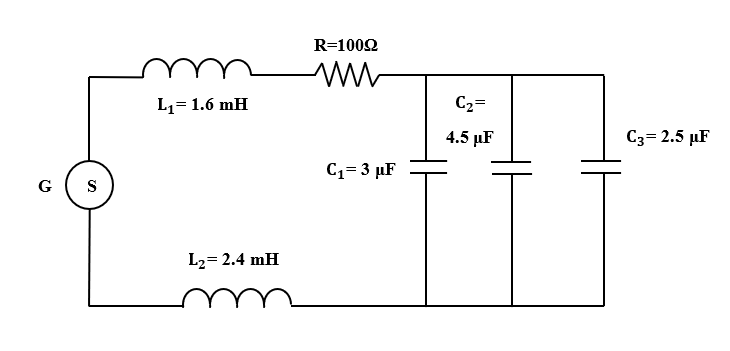
An ac generator G with an adjustable frequency of oscillation is used in the circuit, as shown. Current drawn from the ac source will be maximum if its angular frequency is

$A. { 10 }^{ 5 }{ rad }/{ s }$
$B. { 10 }^{ 4}{ rad }/{ s }$
$C. 5000{ rad }/{ s }$
$D. 500{ rad }/{ s }$

Answer
556.2k+ views
Hint: To solve this problem, first find the equivalent capacitance of the combination of three capacitors which are connected in series. Then, find the equivalent inductance of a combination of inductors which are connected in series. Now, use the formula for angular frequency in terms of equivalent capacitance and equivalent inductance. Substitute the values in the formula and find the angular frequency when the current drawn from the ac source is maximum.
Formula used:
${C}_{eq}= {C}_{1}+ {C}_{2} + {C}_{3}$
${L}_{eq}={L}_{1}+ {L}_{2}$
$\omega= \dfrac {1}{\sqrt {LC}}$
Complete answer:
Given: ${L}_{1}= 1.6 mH$
${L}_{2}= 2.4 mH$
${C}_{1}= 3 \mu H$
${C}_{2}= 4.5 \mu H$
${C}_{3}= 2.5 \mu H$
$R= 100 \Omega$
All the three capacitors are connected in parallel. So, their equivalent capacitance is given by,
${C}_{eq}= {C}_{1}+ {C}_{2} + {C}_{3}$
Substituting values in above equation we get,
${C}_{eq}= 3 + 4.5 + 2.5$
$\Rightarrow {C}_{eq}= 10 \mu F$
Both the inductors are connected in series. So, their equivalent inductance is given by,
${L}_{eq}={L}_{1}+ {L}_{2}$
Substituting values in above equation we get,
${L}_{eq}= 1.6 + 2.4$
$\Rightarrow {L}_{eq}= 4 mH$
At resonance, angular frequency is given by,
$\omega= \dfrac {1}{\sqrt {LC}}$
$\Rightarrow \omega= \dfrac {1}{\sqrt {{L}_{eq}{C}_{eq}}}$
Substituting values in above equation we get,
$\omega =\dfrac { 1 }{ \sqrt { 4\times { 10 }^{ -3 }\times 10\times { 10 }^{ -6 } } }$
$\Rightarrow \omega =\cfrac { 1 }{ \sqrt { 40\times { 10 }^{ -9 } } }$
$\Rightarrow \omega =\cfrac { 1 }{ 2\times { 10 }^{ -4 } }$
$\Rightarrow \omega= 0.5 \times {10}^{4}$
$\Rightarrow \omega= 5000 Hz$
$\Rightarrow \omega= 5000 { rad }/{ s }$
Thus, Current drawn from the ac source will be maximum if its angular frequency is $5000 { rad }/{ s }$.
So, the correct answer is option C i.e. $5000 { rad }/{ s }$.
Note:
Students must remember that when the capacitors are connected in series, the total capacitance is less than at least any one of the series capacitors individual capacitance. When capacitors are connected in parallel, the total capacitance is the sum of all the capacitors’ capacitances. The equivalent inductance of any two or more inductors connected together in series will always be greater than the value of the largest inductor in the series chain.
Formula used:
${C}_{eq}= {C}_{1}+ {C}_{2} + {C}_{3}$
${L}_{eq}={L}_{1}+ {L}_{2}$
$\omega= \dfrac {1}{\sqrt {LC}}$
Complete answer:
Given: ${L}_{1}= 1.6 mH$
${L}_{2}= 2.4 mH$
${C}_{1}= 3 \mu H$
${C}_{2}= 4.5 \mu H$
${C}_{3}= 2.5 \mu H$
$R= 100 \Omega$
All the three capacitors are connected in parallel. So, their equivalent capacitance is given by,
${C}_{eq}= {C}_{1}+ {C}_{2} + {C}_{3}$
Substituting values in above equation we get,
${C}_{eq}= 3 + 4.5 + 2.5$
$\Rightarrow {C}_{eq}= 10 \mu F$
Both the inductors are connected in series. So, their equivalent inductance is given by,
${L}_{eq}={L}_{1}+ {L}_{2}$
Substituting values in above equation we get,
${L}_{eq}= 1.6 + 2.4$
$\Rightarrow {L}_{eq}= 4 mH$
At resonance, angular frequency is given by,
$\omega= \dfrac {1}{\sqrt {LC}}$
$\Rightarrow \omega= \dfrac {1}{\sqrt {{L}_{eq}{C}_{eq}}}$
Substituting values in above equation we get,
$\omega =\dfrac { 1 }{ \sqrt { 4\times { 10 }^{ -3 }\times 10\times { 10 }^{ -6 } } }$
$\Rightarrow \omega =\cfrac { 1 }{ \sqrt { 40\times { 10 }^{ -9 } } }$
$\Rightarrow \omega =\cfrac { 1 }{ 2\times { 10 }^{ -4 } }$
$\Rightarrow \omega= 0.5 \times {10}^{4}$
$\Rightarrow \omega= 5000 Hz$
$\Rightarrow \omega= 5000 { rad }/{ s }$
Thus, Current drawn from the ac source will be maximum if its angular frequency is $5000 { rad }/{ s }$.
So, the correct answer is option C i.e. $5000 { rad }/{ s }$.
Note:
Students must remember that when the capacitors are connected in series, the total capacitance is less than at least any one of the series capacitors individual capacitance. When capacitors are connected in parallel, the total capacitance is the sum of all the capacitors’ capacitances. The equivalent inductance of any two or more inductors connected together in series will always be greater than the value of the largest inductor in the series chain.
Recently Updated Pages
Basicity of sulphurous acid and sulphuric acid are

Master Class 12 Business Studies: Engaging Questions & Answers for Success

Master Class 12 Economics: Engaging Questions & Answers for Success

Master Class 12 English: Engaging Questions & Answers for Success

Master Class 12 Maths: Engaging Questions & Answers for Success

Master Class 12 Social Science: Engaging Questions & Answers for Success

Trending doubts
What are the major means of transport Explain each class 12 social science CBSE

Which are the Top 10 Largest Countries of the World?

Draw a labelled sketch of the human eye class 12 physics CBSE

How much time does it take to bleed after eating p class 12 biology CBSE

Explain sex determination in humans with line diag class 12 biology CBSE

Differentiate between homogeneous and heterogeneous class 12 chemistry CBSE




